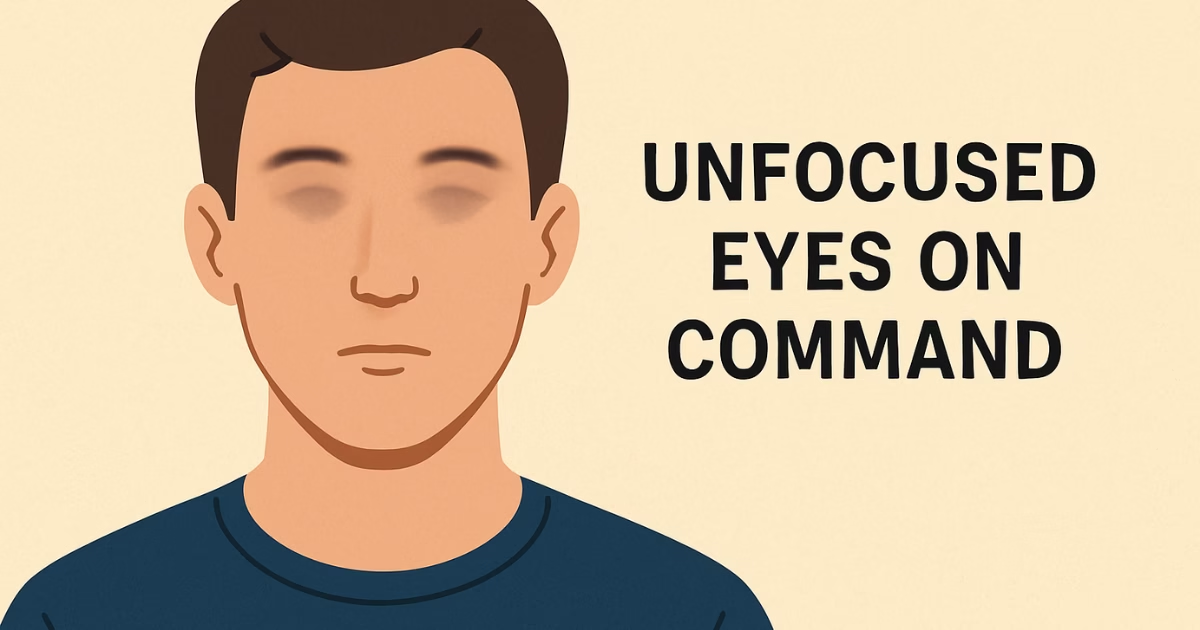Ever heard of unfocused eyes on command? It might sound strange, but many people can actually make their eyes blur out on purpose. It’s like your eyes go soft, and the world around you suddenly feels a bit distant. Some do it while daydreaming. Others use it as a trick to relax or see 3D images. Surprisingly, it’s not some rare talent—it’s something most people can learn.
This skill isn’t just for fun either. It can help you relax, boost focus, and even improve vision exercises. Still, a lot of folks don’t really know what it is or how it works. In this blog, we’ll break it all down. What it is, how it works, and how you can learn to do unfocused eyes on command yourself—without hurting your eyes.
What Does “Unfocused Eyes on Command” Mean?
“Unfocused eyes on command” means the ability to make your vision blur intentionally. You’re not going blind or zoning out. Instead, you’re relaxing your eyes just enough so they stop focusing on any single object. The result? A soft blur, like a dreamy filter over the world.
Most people do this by accident. Maybe while staring at a wall or spacing out in class. But with a little awareness, you can do it anytime you want. It’s a conscious decision to relax your focus—like letting go of a tight grip. It’s kind of like putting your eyes into “neutral gear.”
This isn’t the same as going cross-eyed or losing control. You’re still in charge. It’s just that your eyes are resting, not locked in on anything specific. And yep, it’s something you can learn with a little practice.
The Science Behind It: How Our Eyes Focus and Unfocus
Your eyes are built for sharp focus. That’s thanks to a part inside your eye called the lens. The lens changes shape depending on how far away the object is. This action is called “accommodation.” Tiny muscles around the lens squeeze or relax to help you see clearly.
When you unfocus your eyes on purpose, you’re doing the opposite. You’re telling those muscles to chill out. Instead of sharpening vision, your eyes go soft and let objects blur. There’s no damage in this—it’s actually a natural thing your eyes do all the time, especially when they’re tired.
This “unfocused” mode also happens when both eyes stop trying to converge on one point. Convergence means your eyes turn slightly inward to look at something close. Unfocusing means you stop doing that—your eyes go a bit parallel. It’s totally safe and can feel pretty relaxing.
Can Everyone Do It?
Not everyone can do unfocused eyes on command right away, and that’s totally normal. It depends on your eye coordination, muscle flexibility, and even how stressed you are. Some people discover they can do it by accident. Others might need to train their eyes a bit.
If someone struggles with this, it doesn’t mean something is wrong. It might just be that their eyes are always working hard to stay focused. People who wear strong glasses or have eye alignment issues might find it tricky. But the good news? With patience and simple exercises, almost anyone can learn it.
Vision therapists often use similar techniques to help patients. They help train eye muscles and improve coordination. So if it’s tough at first—don’t worry. Like anything else, practice helps. You’re teaching your eyes to chill.
Is It Harmful or Safe?
Here’s the quick answer: Yes, it’s safe. Unfocusing your eyes on command isn’t dangerous or harmful to your vision. You’re not damaging anything or forcing your eyes into a weird position.
In fact, it can even be good for your eyes. Think of it as a stretch. Your eyes are focusing all day—on phones, screens, books. Giving them a moment to rest is a break they actually need. It’s like letting your brain daydream.
That said, there are a few things to watch for. If you feel dizzy, get double vision, or experience eye pain, that’s not normal. Stop and rest. And if it keeps happening, maybe check with an eye doctor.
For most people though, doing this for a few minutes is completely harmless. Just don’t overdo it or try to force it. Relaxation is the whole point.
Why Would You Want to Unfocus Your Eyes?
At first, it might seem like a party trick. But there are actually real benefits to learning this skill.
- Relaxation: Letting your eyes blur is super calming. It gives your brain a mental break.
- Meditation: Some people use this soft gaze method in mindfulness practices. It helps them stay in the moment.
- Eye exercises: Vision therapists use similar techniques to reduce eye strain.
- Improved focus: Weirdly, learning to unfocus can help you focus better after. It resets your visual system.
- 3D images: Ever seen those “magic eye” pictures? You need this skill to see them properly.
So yeah—it’s more than just zoning out. It’s like a hidden skill that helps your mind and body slow down.
How to Learn Unfocused Eyes on Command
Alright, want to try it? Here’s a step-by-step guide to learn unfocused eyes on command.
Step 1: Pick a Plain Background
Look at a blank wall or ceiling. Somewhere with no distractions.
Step 2: Let Your Eyes Rest
Don’t try to “look” at anything. Let your eyes go soft. It’s okay if things blur.
Step 3: Use the “Through” Method
Put your hand in front of your face. Instead of looking at it, look “through” it—like you’re looking at something far behind.
Step 4: Try with Printed Text
Hold a book close, then look “past” the text until it blurs. This trains the unfocus effect.
Step 5: Blink and Relax
If your eyes water or hurt, blink and rest. It’s all about being gentle.
The more you practice, the easier it becomes. Soon, you’ll be able to blur things on demand.
Common Mistakes and Misconceptions
Let’s clear up a few things people get wrong about unfocused eyes on command:
- It’s not going cross-eyed. Cross-eyed means both eyes move inward. Unfocusing is more about letting them relax outward.
- It’s not bad for your vision. Unless you’re overdoing it for hours (who would though?), it’s safe.
- It doesn’t mean you have poor eyesight. Anyone can learn to do it—even people with perfect vision.
- Don’t force it. This is the big one. If you’re trying too hard, it won’t work. Just relax.
Trying to rush this will only make it harder. Think of it like floating in a pool. The more you struggle, the less it happens.
Real-Life Uses and Fun Tricks
People use this skill in more ways than you’d think:
- Magic Eye puzzles: You need to unfocus your eyes to see those hidden 3D shapes.
- Artists and photographers: Some use a soft gaze to judge composition and balance.
- Meditators: A soft, unfocused gaze can deepen calm states.
- Actors and performers: Some actors use this to appear “lost in thought” on stage.
- People just bored in meetings: (Okay, maybe not a real use… but still common!)
It’s a neat tool once you know how to control it. And honestly, it’s kind of fun.
Also Read: Top Souvenirs from USA: Iconic Keepsakes to Take Home
Frequently Asked Questions (FAQs)
Q: Can this hurt your eyes?
A: Nope, not if done gently. Just don’t strain or hold the blur too long.
Q: Is it related to hypnosis?
A: Not really. But both involve a relaxed focus state.
Q: Can kids do this?
A: Yes, some can naturally! But teaching them gently is important.
Q: I see double when I try. Is that okay?
A: It can happen. If it’s uncomfortable or frequent, talk to an eye doctor.
Q: Can this improve my vision?
A: Not directly, but it may help reduce strain and train better focus habits.
Final Thoughts: Is It Worth Learning?
So, is it useful to master unfocused eyes on command? Definitely. It’s a weirdly helpful trick that’s easy, relaxing, and just plain interesting. Once you learn it, you’ll find yourself using it without even trying. During breaks, before bed, or when your brain just needs to drift a little.
It’s not a superpower, but it kinda feels like one when you get the hang of it. So go ahead—give it a try. Let your eyes chill for once.

Hi, I’m Shafy Ali – a curious mind and passionate writer at Celiac Magazine. I cover a little bit of everything, from everyday tips and how-tos to deeper dives into topics that spark conversation. I enjoy turning research into readable, relatable content that informs and inspires. Whatever the subject, I aim to keep it clear, engaging, and genuinely useful.

